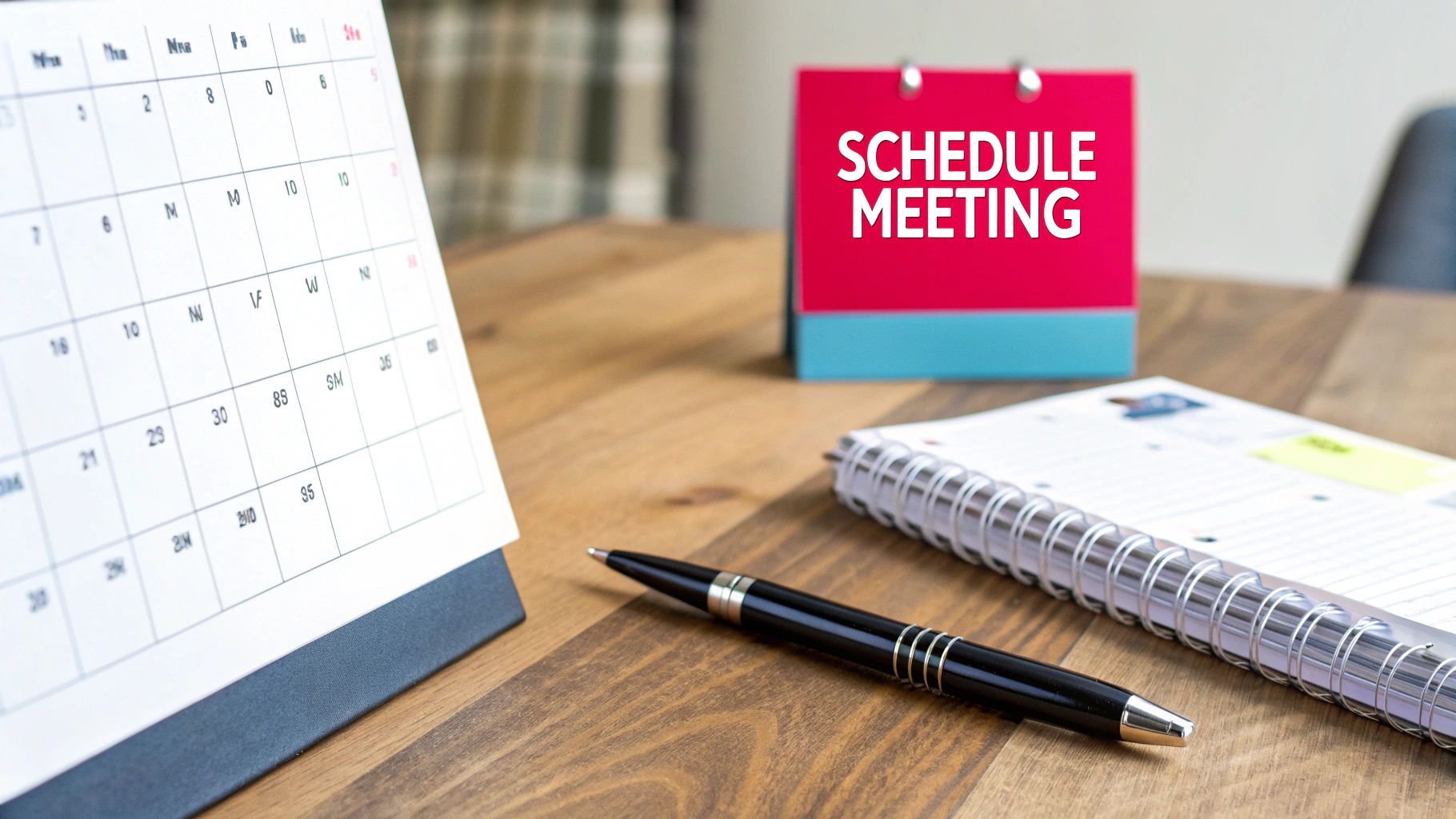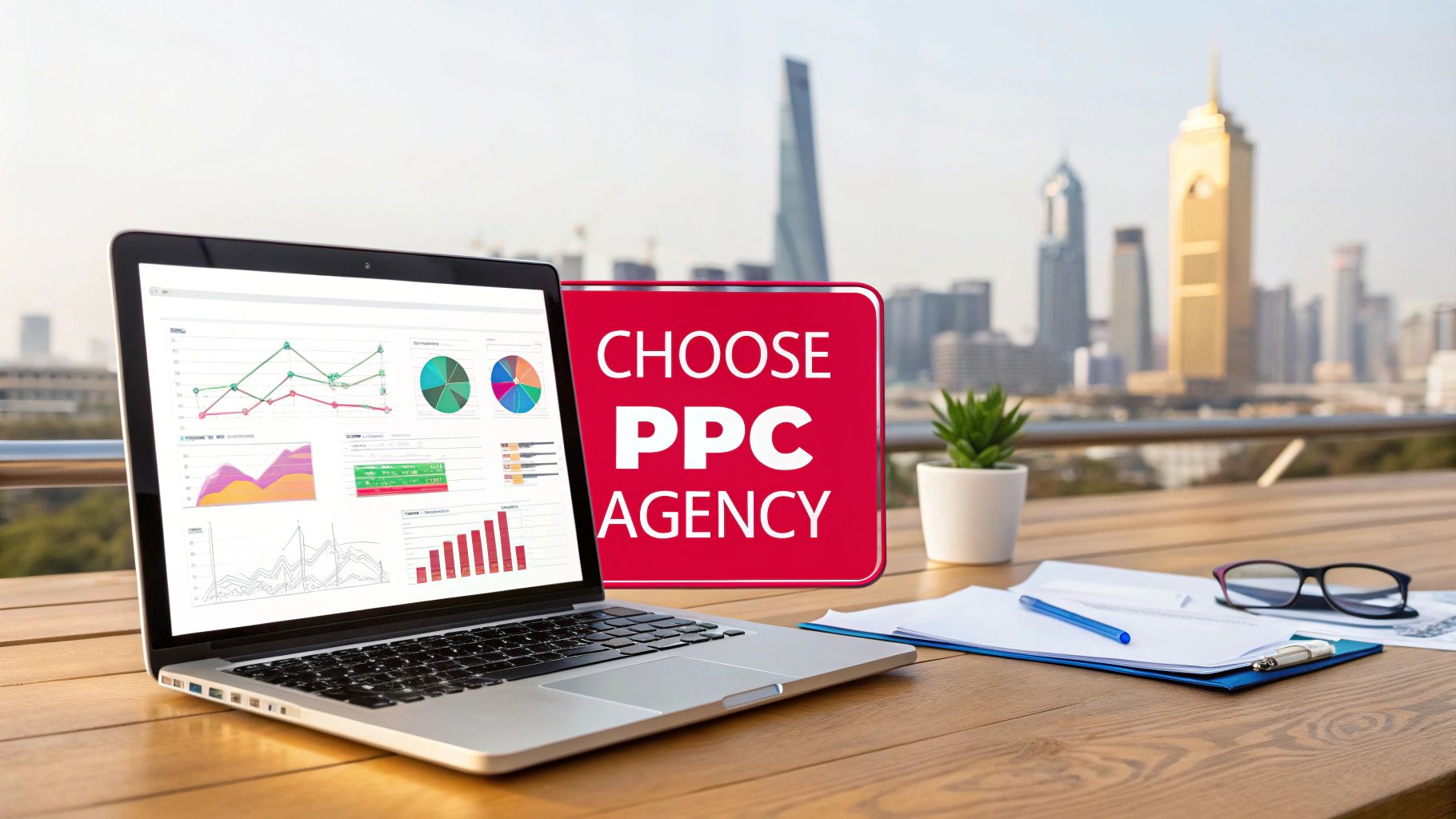Transform Your Inbox: The Power of Effective Email Templates
Crafting effective business emails can be a challenge. This curated list of eight essential business email templates provides a structured framework for various communication scenarios, saving you time and improving your results. You'll learn how to write compelling emails for outreach, follow-ups, thank you notes, proposals, and more. We'll dissect each template, providing strategic insights and actionable takeaways.
Before diving into templates, it's helpful to understand the basics of effective email writing. For a step-by-step guide, see: Writing Effective Professional Emails
This listicle will cover these key business email templates:
- Cold Sales Outreach
- Follow-Up
- Welcome
- Meeting Request
- Promotional
- Customer Support
- Newsletter
- Thank You
Mastering these templates will empower you to:
- Increase open and click-through rates: Learn subject line strategies and compelling calls to action.
- Boost conversions: Discover persuasive language and effective structuring techniques.
- Enhance customer relationships: Build rapport through personalized and professional communication.
- Streamline your workflow: Save time by leveraging pre-written templates tailored for specific purposes.
These templates offer replicable strategies, giving you the tools you need to elevate your email game and enhance your business communication. Whether you're a startup founder in the UAE or an established corporation, these templates will prove invaluable. We'll analyze examples, extract specific tactics, and focus on the why behind their effectiveness.
1. Cold Sales Outreach Email Template
A cold sales outreach email template is your first impression with a potential client who has no prior connection to your business. It's a crucial tool for generating leads and initiating conversations. Effective templates focus on delivering immediate value, building rapport, and sparking interest in your product or service. This is achieved through personalized, research-driven messaging that resonates with the recipient. Think of it as a digital handshake, carefully crafted to open doors to new business opportunities.

Examples of Successful Implementation
- HubSpot: Their templates offer industry-specific customization, allowing you to tailor your message to the recipient's specific needs and pain points.
- Salesforce: Leveraging AI, Salesforce creates dynamic email sequences that adapt based on recipient engagement. This allows for a more personalized and effective follow-up process.
- LinkedIn Sales Navigator: Integration templates streamline the process of connecting with prospects on LinkedIn, leveraging existing profile data for personalization.
Actionable Tips for Crafting Effective Cold Emails
- Research: Understand the recipient's recent achievements, company news, and industry challenges. This allows you to personalize your outreach and demonstrate genuine interest.
- Brevity: Keep initial emails concise, ideally under 150 words. Respect your recipient's time and get straight to the point.
- A/B Testing: Experiment with different subject lines to determine what resonates best with your target audience. Track open rates and click-through rates to optimize your approach.
- Follow Up: Persistence is key. Follow up 2-3 times with different angles, providing additional value in each subsequent email.
- Unsubscribe Option: Always include a clear and easy unsubscribe option. Respecting recipient preferences builds trust and strengthens your brand reputation.
When and Why to Use Cold Outreach
Cold outreach is particularly effective when targeting specific demographics or industries, especially in B2B settings. It's a powerful tool for:
- Lead Generation: Identify and connect with potential customers who fit your ideal client profile.
- Brand Awareness: Introduce your business to a new audience and establish your expertise.
- Business Development: Open doors to new partnerships and collaborations.
This method's power lies in its targeted approach and ability to initiate conversations. While not every cold email will convert, a well-crafted strategy, built on personalization and value, can significantly boost your sales pipeline. Learn more about Cold Sales Outreach Email Template. This proactive approach is crucial for businesses looking to scale their growth and reach new markets, making it a vital part of any successful email marketing strategy. By understanding the nuances of crafting compelling cold emails, you can effectively connect with potential clients and unlock significant business opportunities.
2. Follow-Up Email Template
A follow-up email template is a systematic approach to maintaining communication momentum after initial contact, meetings, proposals, or any business interaction. These templates are designed to keep prospects engaged, address concerns, and move the sales process forward. Effective follow-up emails balance professional persistence without appearing pushy, nurturing leads and building rapport. This is achieved through providing value, reiterating key points, and prompting further action. Think of it as a gentle nudge, strategically timed to guide the prospect towards a positive decision.

This infographic illustrates a three-stage follow-up email timeline: the initial follow-up within 24-48 hours, a second touchpoint at 3-5 days, and a final follow-up at 1-2 weeks. The timeline emphasizes consistent engagement and spaced-out communication.
Examples of Successful Implementation
- Zoom/GoToMeeting: Post-demo follow-up sequences are often automated yet personalized, addressing specific features discussed during the presentation.
- McKinsey: Proposal follow-up templates used by consulting firms like McKinsey focus on reiterating value propositions and addressing potential client hesitations.
- Microsoft/Google: Sales teams leverage meeting follow-up templates that summarize key takeaways and outline next steps, fostering clear communication and accountability.
Actionable Tips for Crafting Effective Follow-Up Emails
- Timing: Wait 24-48 hours after the initial contact for your first follow-up.
- Value-Add: Provide new value in each follow-up email. This could be a case study, relevant article, or industry insight.
- Confidence: Use the "assume the sale" approach in later follow-ups, focusing on logistics and implementation details.
- Clarity: Set clear expectations for the next communication, outlining the desired action from the recipient.
- Metrics: Track engagement metrics (open rates, click-through rates) to optimize the timing and content of your follow-up emails.
When and Why to Use Follow-Up Emails
Follow-up emails are essential in virtually all business communication scenarios. They are particularly crucial for:
- Nurturing Leads: Maintain consistent engagement with potential clients to build relationships and move them through the sales funnel.
- Closing Deals: Address lingering questions or concerns and guide prospects towards a positive buying decision.
- Customer Success: Follow up after onboarding or product launches to ensure client satisfaction and identify potential upsell opportunities.
For more examples of effective outreach, check out this article on cold email templates b2b. Consistent follow-up maximizes your chances of converting leads and building long-term business relationships. This proactive communication strategy allows you to stay top-of-mind, demonstrate genuine interest, and ultimately drive business growth. By mastering the art of the follow-up email, you can significantly improve your conversion rates and strengthen client relationships.
3. Welcome Email Template
A welcome email template is an automated message sent immediately after a customer signs up, makes a purchase, or subscribes to a service. It serves as the first formal interaction and sets the tone for the entire customer relationship. This crucial touchpoint provides essential information, guides new users through their initial experience, and fosters a sense of connection with your brand. Think of it as a virtual welcome mat, inviting customers into your brand ecosystem.

Examples of Successful Implementation
- Airbnb: Their welcome emails offer personalized local recommendations, enhancing the customer's travel experience and fostering a sense of community.
- Spotify: Using a personalized music onboarding sequence, Spotify guides new users through playlist creation and music discovery, maximizing engagement and platform stickiness.
- Slack: Streamlined team setup and feature introduction emails ensure a smooth onboarding process, minimizing friction and maximizing user adoption.
Actionable Tips for Crafting Effective Welcome Emails
- Timing: Send the welcome email within one hour of signup or purchase. This capitalizes on the customer's initial enthusiasm and reinforces their decision.
- Clarity: Use a clear subject line like "Welcome to [Company Name]" to ensure the email is recognized and opened.
- Immediate Value: Provide instant access to purchased content or services to deliver on the initial promise and build customer satisfaction.
- Community Building: Include social media links to encourage engagement and foster a sense of belonging.
- Automation: Set up automated delivery to ensure consistent communication and streamline the welcome process.
When and Why to Use Welcome Emails
Welcome emails are essential for any business that interacts with customers online. They are particularly effective for:
- Onboarding: Guide new users through the initial setup and features of your product or service.
- Relationship Building: Establish a positive first impression and foster a sense of connection.
- Driving Engagement: Encourage immediate interaction with your platform or content.
The power of welcome emails lies in their ability to nurture nascent customer relationships and set the stage for long-term engagement. A well-crafted welcome series can significantly improve customer retention and drive business growth. By understanding the nuances of crafting effective welcome emails, you can create a positive and engaging first impression that resonates with your target audience and sets the stage for a fruitful customer journey. This proactive approach is crucial for businesses seeking to cultivate strong customer relationships and maximize lifetime value.
4. Meeting Request Email Template
A meeting request email template streamlines the scheduling process, ensuring clear communication and efficient time management. This template provides recipients with all the essential details upfront, allowing them to easily accept or propose alternative times. A well-crafted meeting request fosters professionalism and sets the stage for a productive discussion. It's a crucial tool for anyone who regularly schedules meetings, from sales professionals to executive assistants.

Examples of Successful Implementation
- Calendly: Automates meeting scheduling and sends confirmation emails, freeing up time for both organizer and attendee.
- Microsoft Outlook: Offers customizable meeting invitation templates that integrate seamlessly with calendars, ensuring effortless scheduling.
- Google Calendar: Provides smart scheduling suggestions and integrates with various video conferencing platforms.
- Oracle/SAP Sales Teams: Utilize structured meeting request templates within their CRM systems to ensure consistency and track communication.
Actionable Tips for Crafting Effective Meeting Requests
- Propose Options: Offer 2-3 specific time slots to accommodate recipient availability.
- Video Conference Link: Include the link directly in the initial request for easy access.
- Timezone Clarity: Clearly specify the timezone or utilize scheduling tools to avoid confusion.
- Advance Notice: Send requests at least 24-48 hours in advance.
- Brief Agenda: Include a concise agenda to highlight the meeting's purpose and value.
When and Why to Use Meeting Request Templates
Meeting requests are essential for any business interaction that requires a dedicated time slot. They are particularly effective for:
- Client Meetings: Scheduling sales calls, consultations, or project updates.
- Internal Meetings: Coordinating team meetings, project discussions, or one-on-ones.
- Interviews: Scheduling candidate interviews and providing necessary information.
The power of a well-crafted meeting request lies in its ability to facilitate efficient communication and respect everyone's time. By implementing these tips, businesses can ensure a smooth and productive meeting process, ultimately contributing to better collaboration and successful outcomes. Using clear and professional business email templates for meeting requests can greatly improve scheduling efficiency.
5. Promotional Email Template
A promotional email template is your direct line to boosting sales and engagement. This marketing-focused template promotes products, services, sales, or special offers to both existing customers and potential prospects. Unlike purely transactional emails, effective promotional templates balance persuasive copywriting and compelling visuals with genuine value delivery. They nurture customer relationships while driving conversions, making them a cornerstone of any successful email marketing strategy. Think of them as digital flyers, strategically designed to capture attention and inspire action.
Examples of Successful Implementation
- Amazon: Their personalized product recommendation emails leverage browsing history and purchase data, suggesting relevant items that resonate with individual customer preferences.
- Target: Weekly promotional circulars highlight current deals and discounts, driving traffic both online and in-store. They often segment their audience to tailor promotions based on demographics and shopping habits.
- Sephora: Beauty Insider exclusive offers reward customer loyalty with early access to sales, personalized recommendations, and bonus points, strengthening customer relationships and encouraging repeat purchases.
Actionable Tips for Crafting Effective Promotional Emails
- A/B Test Subject Lines: Experiment with different subject lines to identify what resonates most with your target audience. Analyzing open rates helps optimize your approach and grab attention.
- Segmentation: Tailor your message to specific customer segments based on demographics, purchase history, or browsing behavior. Personalized offers significantly increase conversion rates.
- Mobile Optimization: Ensure your email renders correctly on all devices, including smartphones and tablets. A seamless mobile experience is crucial in today's mobile-first world.
- Urgency (Without Misleading): Create a sense of urgency by highlighting limited-time offers or low stock levels. However, always maintain transparency and avoid misleading tactics.
- Value-Driven Promotion: Balance promotional content with valuable information, such as helpful tips, exclusive content, or early access to new products.
When and Why to Use Promotional Emails
Promotional emails are essential for driving sales, building brand awareness, and nurturing customer relationships. They are particularly effective for:
- Product Launches: Generate excitement and drive early adoption of new products or services.
- Sales and Promotions: Boost sales by offering discounts, bundles, or special offers.
- Seasonal Campaigns: Capitalize on holidays and seasonal trends to promote relevant products and services.
- Customer Retention: Reward loyal customers with exclusive offers and personalized recommendations.
The strength of promotional emails lies in their ability to reach a targeted audience with compelling offers and valuable information. Learn more about Promotional Email Template. This proactive approach, when executed with strategic precision, can significantly impact your bottom line and foster lasting customer loyalty, making it an indispensable tool for any business seeking growth and engagement.
6. Customer Support Email Template
A customer support email template provides a structured framework for customer service teams to address inquiries, complaints, and support requests. These templates ensure consistent, professional communication while boosting response efficiency and maintaining a unified brand voice. Effective templates balance standardized responses with personalized elements, creating a positive customer experience even when resolving complex issues. This ultimately strengthens customer relationships and fosters loyalty.
Examples of Successful Implementation
- Zappos: Known for its exceptional customer service, Zappos uses templates that inject personality and humor into their responses, creating a memorable and positive interaction.
- Apple Support: Their technical troubleshooting email sequences guide customers through step-by-step solutions, providing clear instructions and helpful resources.
- Zendesk: This platform offers automated support ticket responses for common inquiries, freeing up agents to focus on more complex issues. This automated system ensures prompt acknowledgment and initial support.
- Amazon: Their order issue resolution templates streamline the process of addressing shipping problems, returns, and refunds, ensuring a smooth and efficient resolution for customers.
Actionable Tips for Crafting Effective Customer Support Emails
- Personalization: Include customer-specific information like their name and order number to show individual attention.
- Positive Language: Frame responses positively, even when addressing problems. Focus on solutions and avoid negative phrasing.
- Timeframes: Provide estimated resolution timeframes to manage customer expectations.
- Contact Options: Offer multiple contact options, like phone or live chat, for urgent issues.
- Follow Up: Ensure complete issue resolution by following up with customers after initial contact.
When and Why to Use Customer Support Email Templates
Customer support email templates are essential for any business interacting with customers online. They are particularly valuable for:
- Efficient Responses: Handle high volumes of inquiries quickly and consistently.
- Brand Consistency: Maintain a uniform brand voice and messaging across all customer interactions.
- Improved Customer Satisfaction: Provide prompt and helpful support, leading to increased customer happiness.
- Reduced Support Costs: Streamline the support process and free up agents to handle complex issues.
Using customer support email templates offers a strategic approach to managing customer interactions. It allows businesses to deliver efficient, personalized support, fostering positive relationships and driving customer loyalty. This proactive approach to communication is invaluable for businesses seeking to enhance customer satisfaction and build a strong brand reputation.
7. Newsletter Email Template
A newsletter email template is your ongoing connection with subscribers, delivering valuable content directly to their inbox. It's a crucial tool for nurturing leads, building brand loyalty, and subtly promoting your products or services. Effective newsletter templates focus on providing consistent value through a mix of informative content, company updates, industry insights, and curated resources. Think of it as a regular conversation, keeping your audience engaged and informed about your brand and its offerings.
Examples of Successful Implementation
- Morning Brew: This financial news digest uses a concise, witty style to deliver complex information in an engaging way, capturing a millennial audience. Their success stems from their ability to make finance accessible and entertaining.
- HubSpot: They offer in-depth marketing and sales insights, establishing themselves as thought leaders in the industry. This value-driven approach positions HubSpot as a trusted resource and subtly promotes their services.
- Shopify: By sharing e-commerce tips and success stories, Shopify empowers its users and fosters a sense of community. This strategy strengthens customer relationships and encourages platform engagement.
Actionable Tips for Crafting Effective Newsletters
- Consistency: Maintain a regular sending schedule (weekly or monthly) to establish a predictable rhythm for your audience.
- Compelling Subject Lines: Craft subject lines that create curiosity and encourage opens. A/B test different approaches to optimize your open rates.
- Content Mix: Balance educational content with subtle promotional messages to provide value while driving conversions.
- Mobile Optimization: Ensure your newsletter is easily readable on mobile devices, as a significant portion of your audience will likely access it on their phones.
- Metrics Tracking: Monitor key metrics like open rates, click-through rates, and unsubscribes to understand what resonates with your audience and refine your approach.
When and Why to Use Newsletter Emails
Newsletter emails are essential for businesses looking to build long-term relationships with their audience. They are particularly effective for:
- Lead Nurturing: Educate potential customers about your offerings and guide them through the sales funnel.
- Brand Building: Establish your brand as a thought leader and build trust with your audience.
- Community Building: Foster a sense of community around your brand by sharing valuable insights and connecting with your subscribers.
This method's power lies in its ability to provide consistent value and build lasting connections. Learn more about Newsletter Email Template. While not every subscriber will convert into a customer, a well-crafted newsletter strategy, focused on valuable content and engaging communication, can significantly boost your brand loyalty and drive long-term growth. By understanding the nuances of crafting compelling newsletters, you can effectively nurture your audience and establish your brand as a trusted resource. This ongoing engagement is crucial for businesses seeking sustained growth and strong customer relationships, making newsletters a vital component of any comprehensive email marketing strategy.
8. Thank You Email Template
A thank you email template is a relationship-building tool designed to express gratitude. It strengthens connections with customers, partners, or prospects after positive interactions like purchases, meetings, referrals, or completed projects. These templates not only show appreciation but also encourage repeat business and subtly prompt reviews or referrals, fostering long-term engagement. Think of it as a digital thank you note, adding a personal touch in the digital age.
Examples of Successful Implementation
- Airbnb: Post-stay thank you emails often include photo memories from the trip, creating a personalized and nostalgic touch.
- Amazon: Post-purchase thank you emails seamlessly integrate review requests, leveraging the immediate post-purchase satisfaction for valuable feedback.
- Service-based businesses: Consulting firms or agencies send thank you emails after project completion, reinforcing the value delivered and opening the door for future collaborations.
- Event organizers: Post-event thank you emails with recap content and links to presentations offer continued value and encourage future attendance.
Actionable Tips for Crafting Effective Thank You Emails
- Timing: Send within 24 hours of the interaction to capitalize on positive sentiment.
- Specificity: Include details about the interaction, showing you value the individual and their engagement.
- Value-add: Offer a discount, resource, or guide to enhance the recipient's experience.
- Feedback: Make it easy to provide feedback or reviews with clear call-to-actions.
- Tone: Maintain a warm, conversational tone to build rapport. To maximize the effectiveness of your campaigns, it's a good idea to review some email newsletter best practices.
When and Why to Use Thank You Emails
Thank you emails are relevant across various business interactions, from e-commerce transactions to professional services. They are particularly powerful for:
- Customer Retention: Expressing gratitude fosters loyalty and encourages repeat business.
- Relationship Building: Strengthening connections with clients and partners leads to long-term collaborations.
- Reputation Management: Positive interactions contribute to a strong brand image and word-of-mouth referrals.
- Gathering Feedback: Thank you emails provide an opportune moment to solicit valuable feedback for improvement.
This simple gesture can significantly impact customer relationships. While often overlooked, a well-crafted thank you email, personalized and timely, can elevate your brand and solidify your connection with your audience, making it a valuable asset in any business email template arsenal.
Comparison of 8 Business Email Templates
| Email Template | Implementation Complexity 🔄 | Resource Requirements 🔄 | Expected Outcomes 📊 | Ideal Use Cases 💡 | Key Advantages ⭐ |
|---|---|---|---|---|---|
| Cold Sales Outreach Email | Moderate – requires personalization and research | Moderate – automation tools and research time | Low response rates (1-5%), measurable opens and replies | Initiating contact with cold prospects | Scalable, cost-effective lead generation |
| Follow-Up Email | Moderate to High – sequence planning and timing crucial | High – tracking systems, content variety | Increases conversion rates by 70%, maintains engagement | Post-initial contact or meeting follow-up | Boosts conversions, professional persistence |
| Welcome Email | Low – mostly automated with set triggers | Low – automation platform or CRM | Very high open rates (50-86%), improved engagement & retention | New customer onboarding or subscription | Strong first impression, reduces support queries |
| Meeting Request Email | Moderate – requires detailed info & scheduling integration | Moderate – calendar tools, agenda prep | Higher meeting acceptance, reduced scheduling back-and-forth | Scheduling professional meetings or calls | Saves time, increases acceptance rates |
| Promotional Email | Moderate – design, segmentation, and timing matter | Moderate to High – creative and marketing input | Direct revenue generation, measurable ROI | Product launches, sales, special offers | Drives revenue, brand engagement |
| Customer Support Email | Low to Moderate – templated responses with personalization | Moderate – knowledge base and CRM integration | Faster response times, consistent service quality | Responding to customer inquiries and issues | Scales support, reduces errors |
| Newsletter Email | High – ongoing content creation and scheduling | High – content team, design resources | Builds long-term relationships, traffic driver | Regular communication and content marketing | Establishes thought leadership, engagement |
| Thank You Email | Low – simple templates with personalization | Low – automated or manual sending | Strengthened relationships, encourages loyalty | Post-purchase, meetings, referrals | Builds loyalty, encourages reviews & repeat business |
Level Up Your Communications: Implementing and Optimizing Your Email Templates
Throughout this article, we've explored a range of business email templates, from cold outreach to thank you notes, and dissected the strategies behind their effectiveness. We've seen how a well-crafted subject line can dramatically increase open rates, how personalization can foster stronger connections, and how a clear call to action can drive conversions. Mastering these elements is crucial for anyone seeking to leverage the power of email in today's business landscape. Remember, effective business email templates are more than just pre-written messages; they're strategic tools for building relationships, driving engagement, and achieving your business objectives.
Key Takeaways for Optimized Email Communication
Let's recap the essential takeaways for maximizing the impact of your business email templates:
- Targeted Personalization: Generic emails get lost in the noise. Tailor your messages to resonate with the specific recipient, demonstrating you understand their needs and value their time.
- Compelling Subject Lines: Your subject line is your first (and sometimes only) impression. Make it count by creating intrigue and clearly communicating the email's value.
- Clear Call to Action: Guide your recipients towards the desired outcome. Whether it's scheduling a meeting, downloading a resource, or making a purchase, a clear call to action is essential for driving conversions.
- Mobile Optimization: In today’s mobile-first world, ensuring your emails are easily readable on any device is paramount for reaching your audience effectively.
- A/B Testing: Don't rely on guesswork. A/B test different elements of your emails, such as subject lines and calls to action, to identify what resonates best with your audience.
From Template to Triumph: Next Steps for Email Mastery
Implementing and optimizing your business email templates is an ongoing process. Here's how to turn these insights into tangible results:
- Analyze Your Current Emails: Evaluate your existing email communications. Identify areas for improvement based on the strategies discussed in this article.
- Choose the Right Templates: Select the templates most relevant to your business needs and adapt them to your specific brand voice and target audience.
- Track and Measure: Implement tracking mechanisms to monitor key metrics such as open rates, click-through rates, and conversion rates. Use this data to refine your templates and improve performance.
- Stay Updated: The world of digital communication is constantly evolving. Stay informed about best practices and emerging trends to ensure your email strategies remain effective.
The Power of Strategic Email Communication
By mastering these concepts, you transform your email communications from a routine task into a powerful engine for business growth. Effective email marketing can significantly contribute to lead generation, customer retention, and ultimately, increased revenue. Specifically in the competitive AE market, where businesses constantly vie for attention, strategic email communication can be a crucial differentiator, enabling you to connect with your target audience on a deeper level and drive meaningful engagement.
Ready to elevate your email marketing and unlock its full potential? Grassroots Creative Agency specializes in crafting high-performing email campaigns tailored to your specific business needs, helping you leverage the power of business email templates effectively. Visit Grassroots Creative Agency to discover how we can transform your email communications into a powerful driver of business growth.








